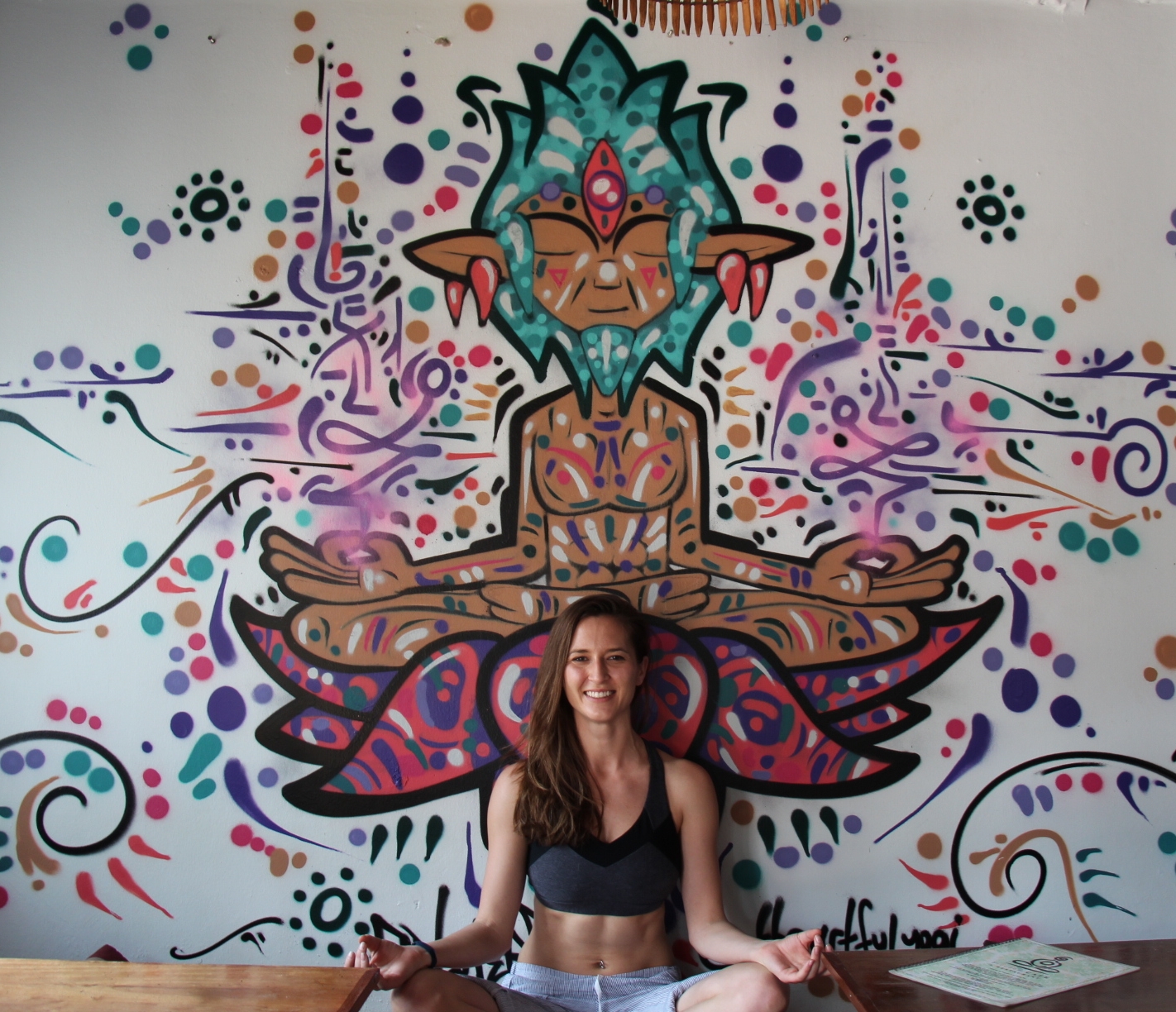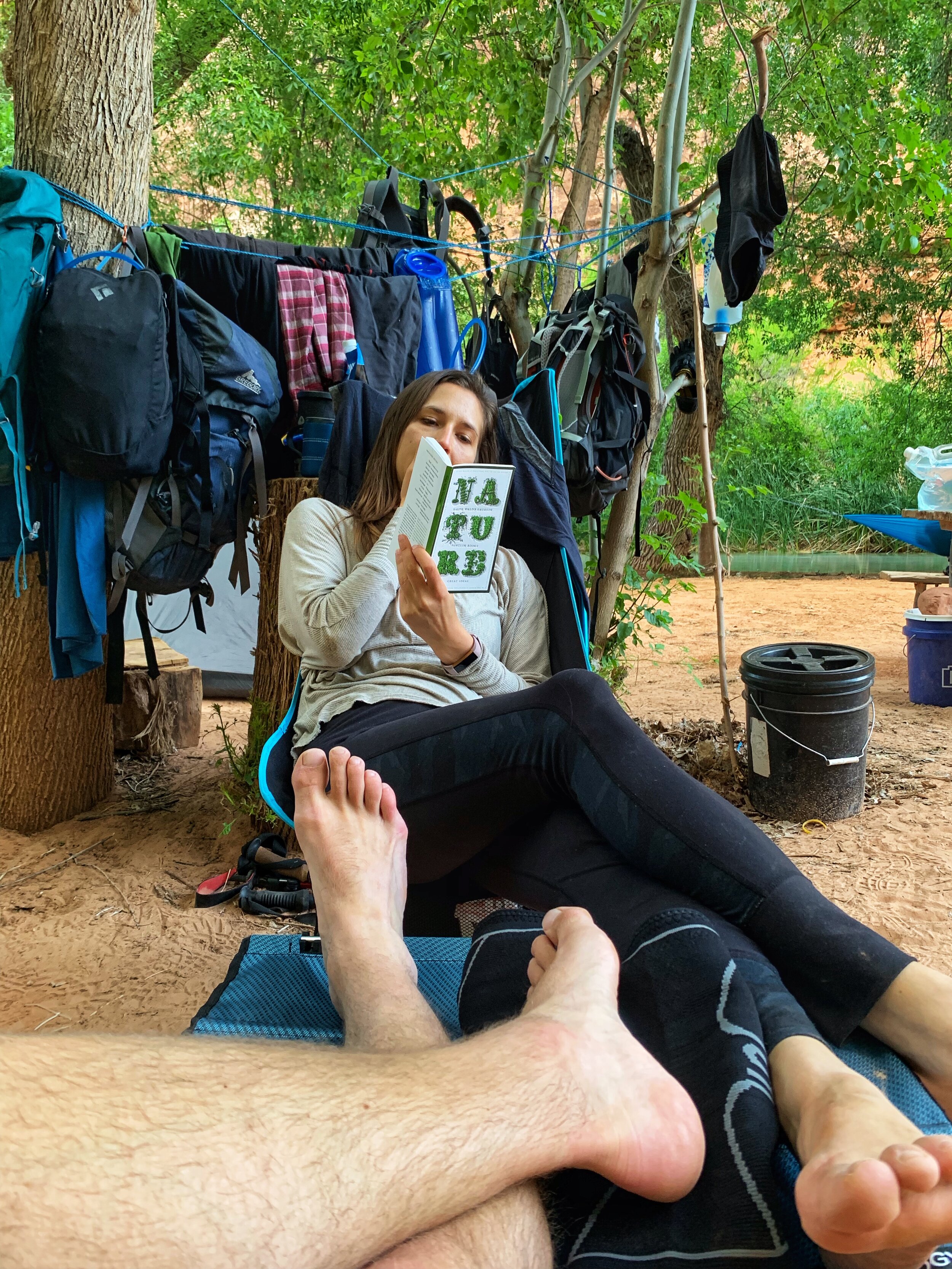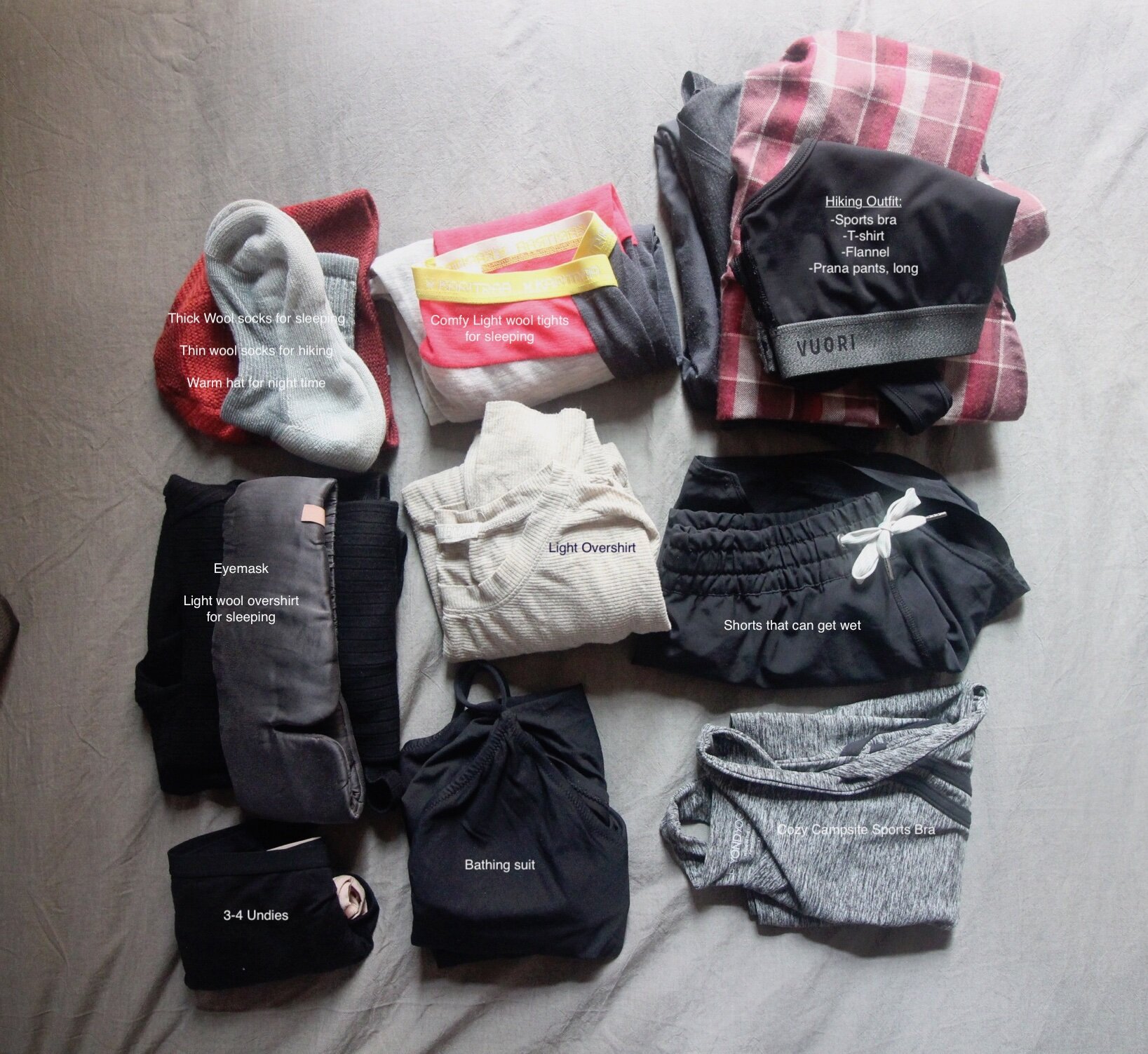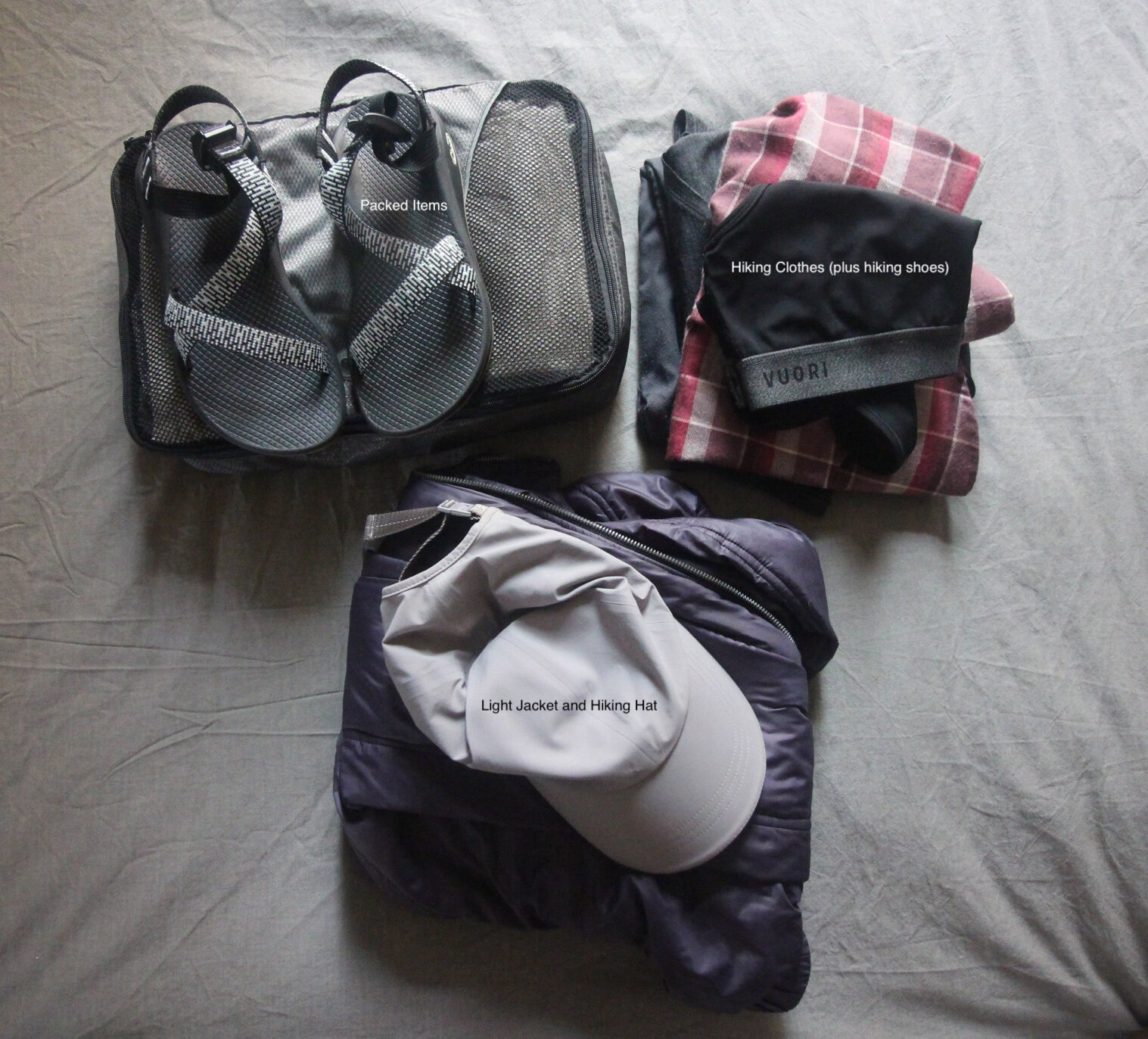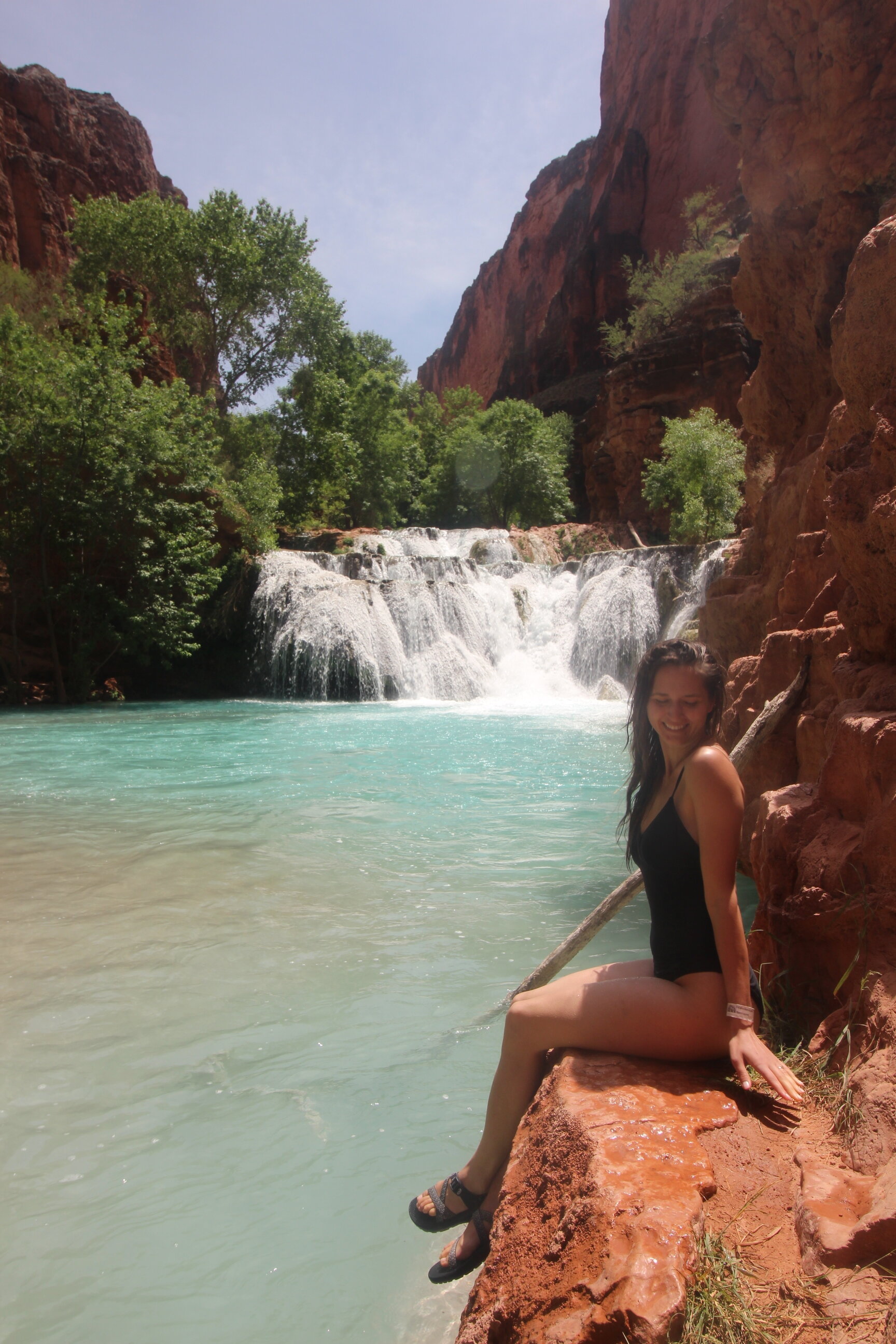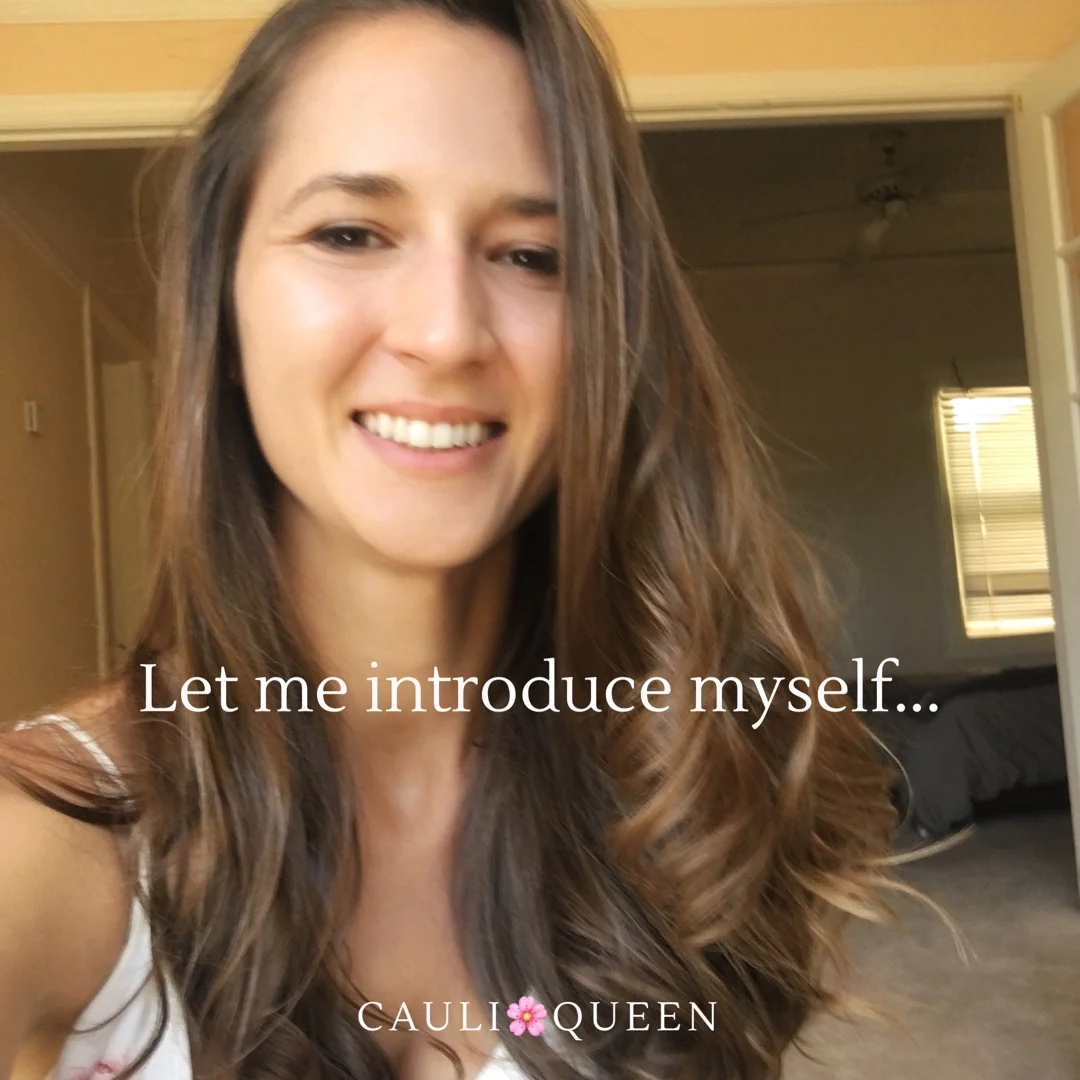How to Supai
The name Havasupai means People of the Blue-Green Water.
The porous limestone lining the Grand Canyon soaks up the rare rain, which pools into the groundwater, and collects into a spring. The deep cliff allows the ground surface and the water table to overlap, and below this natural spring lies a hidden paradise that the Havasupai people have called home for hundreds, possibly even thousands, of years.
Paradise comes at a cost. To get there, you first have to descend through 2 miles of steep switchbacks, straight down into the southern rim of the Grand Canyon. Then hike 10 miles north through the canyon bed (at least you can’t really get lost). If you don’t start early enough, the desert sun, zero water in sight, and all your belongings on your back, could make this 10 miles seem a hell of a lot longer. You are also in a race with all your fellow backpackers to pick the best spots at the first-come first-served camp sites. I imagine being a person who stumbled on this place by accident…
The tiny Supai town tucked away deep in the canyon sells out its campsites within 2 hours of its annual opening, on Feb 1st, FOR THE YEAR.
And to call this place home comes at even more of a cost - a lost civilization. The Supai people fought for almost 100 years to gain back the land torn away from them by white settlers in the 1800’s. Once a hunting/farming community who migrated with the seasons within the canyon for food, the white man’s search for minerals in the rock forced them into isolation from their roaming of over 300 sq miles of land, down to ONE single sq mile of land. Isolated for generations, they were separated just long enough to lose the ways of their own people, their history torn from them other than their grandparents telling them of how it once was. In 1975, much of their land was restored to them, in the largest land grant in American history. But while the land was “given” back, protected, the people had become disconnected from the way their family used to live on it. Instead of being able to embrace their lost way of life, and able to go back to being an independent community, they were now fully dependent on the American food system, living off packaged foods that can survive the trek in from thousands of miles away. The town itself is the last in the continental US to get their mail by mule everyday, and its isolation is part of what leaves this incredible oasis so untouched. As a result of this mental hijacking, almost every native you see deep in the canyon now is obese, living off the “fry bread” and other foods they have came to love from the processed options afforded to them. But at least they have their land back. And the funniest part of all this, most modern Americans CHOOSE to eat this way, and wonder why the majority are fat, sick and blaming themselves for their health troubles, when really they are just part of a broken system that values empty calories over quality of food. This is just an extreme case of isolation where the people have no other option to feeding themselves (that they can remember).
All proceeds for the campground support what is left of this tiny tribe. More history, and a cost breakdown if you would like to visit, in the details below.
Backpacking into the Grand Canyon
Getting tickets: Purchase online Feb 1st, sells out FOR THE YEAR within 1-2 hours of opening
Getting there: We flew into Sedona (4 hour drive to the trailhead), and out of Vegas (3 hour drive), with a rental car for the week. The closest hotel to the trailhead is an hour away.
When to go: Our ideal months to go are around May or October, mild in both the day and night. Direct sunlight is always very hot, and most nights get really cold. The water stays cold year round, and the air always gets fairly chilly once the sun sets. Campfires not allowed. You are deep in a canyon, so the sun is really only out when between the ridges. Most people get up with the sun, and are asleep once dark, around 5am-8pm.
The Campsite: 10 miles from the trailhead parking lot, and 2 miles past the Supai village, you will find a plot of land ready for your choosing. You get to place your tent and hammocks pretty much anywhere within trees, creeks and mini islands, falling asleep to the rushing water surrounding you.
The sites are first come, first served.
The bathrooms are pretty nice for being in the middle of nowhere, with TP and woodchips to cover the smell, but you’ll be showering in the river. Bring only biodegradable soap please! And take out everything you bring in (bring a a personal trash bag to take out with you).
The squirrels are fat, smart, and FEARLESS. Make sure to have some kind of food protection. Otherwise, there aren’t really any bugs or scary animals. Camping humans are usually pretty nice too.
There is a little table of leftovers from campers hiking out, with extra propane and foods, if you end up in need. You can’t fly with propane anyways, and it feels good to leave your extras behind.
There is a single natural spring fountain at the campground, so we didn’t need all the water filters we brought, but good to have just in case.
You pass by the town on your way in and out, but aside from maybe grabbing a few last minute snacks and picking up your permit, you will probably be in a rush to pick out a camp site, or make good time out. At 2 miles each way from the campsite, you can either spend a day to visit, or have it spent in a waterfall or hiking!
Gear List: If hiking in/out, max weight of 23 lb per person is ideal, including water. We made a list of all the stuff we planned to pack, along with the weight of everything we wanted to pack up.
Shoes: We loved our chacos sandals to get in and out of the water (you’ll be walking through rivers once down at camp). I’m also in love with the high top Merrell hiking boots, plus some cheap flip flops for around camp.
Favorite Food: Wild Zora foods were amazing! These, along with Peak dehydrated breakfast meals and a Jetboil made our trip so easy! (You will have to pick up propane, and a pocket knife for good measure, from a local store if you fly in).
Rumpl blanket:Our mega splurge (in weight and price). But super cozy and beautiful!
Lightweight seat with a headrest. Adds a little extra weight, but when exhausted, a little head support makes such a difference! There are picnic tables to share, but it can be nice to make your own little space.
Sedona
Flying into town, we had the option of Vegas or Sedona. We added a few days to check out this beautiful little town, and would go back in a heartbeat. They’re known for having these areas of energy vortices all over the place. At the very least, they were amazing view points!
The sad history of Havasupai
When Columbus set sail in 1492, it was written in journals that the Havasupai people had already lived in the canyon for hundreds of years. They were likely part of the larger native group that had been in the area over 30,000 years. The modern understanding is there was 600 years of peace across the Indians of North America before the foreign settlers arrived.
Within the Grand Canyon, the tribe migrated to different elevations within the canyon based on the season, migrating to the deepest, coolest elevation in the summer. They hunted (deer, elk, sheep and small animals), built mud covered huts in the hot months, and farmed seasonal crops (corn, squash and beans).
By 1882, the canyon was seen as rich with minerals, and the Havasupai people were pushed into a tiny section of their land, to what is less than a single square mile, basically the size of the modern day Supai Village. They could no longer hunt or move with the seasons as their ancestors had. Their way of providing food for themselves was now basically cut off, now supplied by the rations from the American government: cheap corn, sugar, processed flour, flavorings, and processed oils (the sad things that make up most American’s diets today).
Some argue the land in the canyon is un-farmable. But records show one farmer, named Burro, stubbornly kept up his tiny farm at Indian Garden until 1928, when he was finally chased out of the canyon. Somehow, the Indians lived there just fine before the White men chased them into a corner and made them dependent on their food rations of their broken food system.
The last Chief of the Havasupai people, Manakaja, stayed in power of his small group of people until he passed away in 1942. He was the last link between the past and their more modern confinement. As a boy, he roamed the land and lived off the earth. He led the fight to restore the land to his people, and the 1975 legislation to give back to the village was largely due to his continued effort. After 60 years of petitions, and over 30 years after Manakaja’s death, Congress granted back about 276 sq miles to the Havasupai. It was the largest amount of land ever restored to a single tribe.
But handouts 100 years later have their setbacks. The greater land was now as foreign to these natives as it would be for us if we were to roam out into the wild. They are now just an extended leg of the American poverty-stricken societies, but even more isolated to learn from themselves how to recover on their own. They rely fully on campers visiting the valley for income (which admitingly is not cheap), but live off the cheap American foods that have to be purchased and shipped in, the same foods that fill the food desserts in the cities in America. Sadly, walk through the Supai village today, and you will see what eating this food day in and day out does to a population.
The most popular food offered in the canyon? Fry bread. Stale bread fried in cheap oil. You can find it just about anywhere, as a burger, taco, or just as it is. They love it as if it were a staple for generations. Because, now, it kind of has been around that long. We have lost the generations that knew any different. When we said no thank you to the side, we received looks of astonishment, as in, you really don’t want this?! As if they were saying, this is our culture! And it’s so good! How would you get a diabetic child to stop eating this if they had grown up as if it were a cultural necessity?
Is there any way of making their life sustainable again? Do we want it? But by being stuck to a broken system, we only perpetuate the shackels placed on our fellow humans hundreds of years ago, humans that understood the land better than we could imagine. I imagine a world where they can remember, or be taught by some wilderness lover, on how to survive on the real wild again. What if they could not only provide food for themselves again, but could make a profit on fresh food to travelers? As the new waves of modern understanding of nutrition slowly take hold in the states, they continue to be isolated, and will be the last to learn of the nutritional changes taking hold, yearning for lost ways of life that was once their life force, though now comfortable in their unknowing of anything different. They become the last to learn of the changes in a far away world they have been mentally born into. Though the same lineage of their ancestors, on their same land, they are separated from the link of knowledge learned of how to use the land as it had been for centuries. And maybe they like it that way, until the proximally contagious cases of diabetes brings on enough sickness that they can’t last more than another couple generations or so. (Studies of mice on American diets stop being able to reproduce at a certain point. Same thing happened to cats and monkeys. We are really not far behind as a species.)
This is just an amazing story of isolation, a perfect example of what happens when people have to live solely on the foods we are still promoting with our food system.
History of the Canyon
The canyon itself was formed 4 Million years ago, exposing earth that is 2 Billion years old (on a 4B year old planet). To put this in perspective, the dinosaurs lived about 400 Million years ago. This land represents earth from WAY before their time, which is why you won’t find their fossils here. The significance was not lost on geologists, which is also the only reason this land was saved as a National Park in the first place. Each step down into the canyon represents a MILLION years of history in the rocks.
To put all these dates in perspective, consider the life of a human, counting a life in 100 years. Zoom further out to the life of a large tree, hundreds of years old. Further still to earth, then the stars, then the whole planetary and solar systems, with life cycles of billions of years. Our little lives are just a blink of an eye to them.
We visit the wild and see how insignificant we are to mother nature, just as the ants living out their little lives below our feet are to us. But then again, we have found ways to possibly be destructive enough to make a dent. It seems, the longer we live, as we become more “advanced” as a society, the less likely it seems that we could last another 100 years as a species. Maybe we have just hit the limits of our collective intelligence? As a country, America is only 200 years old. The Native Americans were supposedly peaceful with each other for 600, but at least lived amongst each other for 30 THOUSAND years before that. That is also about the time humans were not just homo sapiens, but also had countless different species, skeletons found in faraway places with very different features than ours. The sapiens conquered the water somehow, able to cross oceans and slowly wipe out the other human (and plant and animal) species all around the same time period, until they were the last ones, and the only things left on this planet were the tame ones. Before homo sapiens were the final survivors, the most recent species to have lasted were of skeletons on a tiny secluded Italian island of a group of a dwarf human species. There were also the Neanderthals, having much larger bodies and brains, making up one of the oldest living civilizations, who eventually lost out to the ever-aggressive homo sapiens who learned to kill more methodically: by building large fires, or leading large groups into traps, rather than being able to fight one-on-one. The homo sapiens had shown signs of fighting, and losing, to the Neanderthals, many times over the centuries, but eventually the Neanderthals lost, and paid for it with their existence.
Just think of you and your parents, passing along the torch of your genes. Each generation visiting the canyon will look pretty similar to the generation before them (both the canyon and the people will look pretty similar). But stand there and look up at the vast expanse of one of the single waterfalls, and see the limestone engravings of other water falls that used to be in its place. Imagine the river flowing through this area like a big tidal wave. There are major changes that happen over time, though we only get to see tiny fragments of those changes, through generations. In the same way, we pass along the torches of our own ancestral lines, making slight tweaks every generation until, after enough time, we may be significantly different. Anyways, this is what I think about when I look up at those water falls. How much could I change in one trip?
Staring up at that huge waterfalls, I imagine a movie scene, see the whole dam of water breaking… and all of a sudden you’re just this little thing, a spec of sand to be picked up along the way. No amount of money or power could save you. And once again I am humbled to be just another one of these little things with all this other stuff happening around us we never contemplate because our time scale is so limited.
And these rocks, so geologically significant, are also just beautiful to look at. These rocks were here, hidden from our air for BILLIONS of years, only exposed 4 MILLION years ago... only 4M years.
I have so many conveniences in this world, that I could pay thousands of dollars to take a trip to live off of as little as possible, to see first hand this bright blue/green water, the super old red rocks, the bright stars, all untouched by excess things, or light or noise pollution. This is the stuff dreams are made of, of long lost stories of the wild west, of a beautiful river in the middle of a dessert, of a hidden oasis. There must be a treasure trove of stories told in this exact spot that I will never be able to hear. What stories did people tell who once had access to that lost game of telephone that may have continued for generations and generations before we arrived?
Cost
A park pass for 3 nights (maximum stay) for a couple can be up to $750 through a weekend, or $650 during the week.
Add a mule to carry your packs, at $400 round trip ($50 a bag each way, and a mule can carry 4 bags, but you have to pay per mule). We hiked in with all our stuff, and just paid $100 cash to someone to buy their empty spaces for our two big packs on the way out. This is kind of risky, but we got out with our stuff!
If you time it correctly, the helicopter is a pretty cheap option considering the rest of the prices. $80 per person, including your bags, each way. But also risky, since you’re not guaranteed a spot. They also only operate in the late mornings/early afternoon, on certain days of the week, and only certain months of the year. You could try for this, and if they get full, and you have to hike out (with all your stuff) in the midday sun (def not ideal).
Flights to/from Vegas or Sedona (and any time spent there)
Hotel for the night before/after, or just sleep in the parking lot before your hike (this seemed like a good idea if you want to start really early, bc the closest hotel is about an hour drive away!)
Rental car to/from the airport, to leave in a parking lot for the week (no public transportation)
Lightweight camping gear of your choosing (not cheap)
Resources and fun reads
Exploring Havasupai: A Guide to the Heart of the Grand Canyon, Incredible history and breakdown of the hikes within the canyon, a must read if you are ready to visit.
Nature by Ralph Waldo Emerson, I brought tiny book into the Grand Canyon. There is a reason it has been a best seller for generations. Packed with logic in what feels like poetry, each single page can be read and discussed all day on one of your hikes.
Walden by Henry David Thoreau, Emerson’s student, on what it feels like to live in isolation on a pond, heavily quoted by nature lovers.
Braiding Sweetgrass: Indigenous Wisdom, Scientific Knowledge and the Teachings of Plants, One of my favorite books of all time. A PHD student and lover of ancient wisdom, on her discovery back to her roots. Prose on the important of braiding stories and folklore with modern knowledge, and bringing us back to our connection with the beauty and brilliance of nature.
Into the Canyon, Beautiful documentary available on Netflix. Why is it such a big deal to protect these pristine ecosystems? They can teach us so much about how natural systems work. It is impossible to be in this place and not see how irrelevant we are as human beings. That cuts against the grain of what we as Americans think of ourselves.
Sapiens: A Brief History of Humankind, The first half transformed my way of thinking about human species. We were not the only humans who have called this planet our home, just the ones who conquered. 99% of plant and animal life has been bred out to leave only that which we saw valuable and tameable.
Podcasts on the Grand Canyon and hiking in Supai on the drive in
